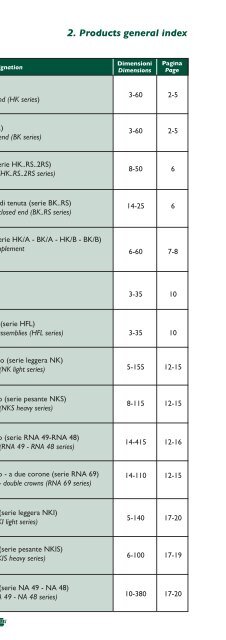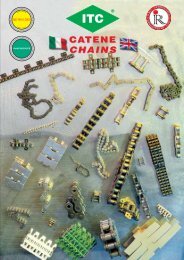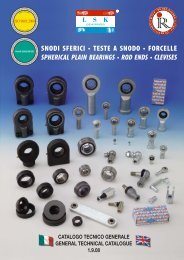ITALCUSCINETTI speed master
ITALCUSCINETTI speed master
ITALCUSCINETTI speed master
You also want an ePaper? Increase the reach of your titles
YUMPU automatically turns print PDFs into web optimized ePapers that Google loves.
5.4 Carico dinamico equivalente P<br />
Il carico dinamico equivalente P su di un cuscinetto<br />
radiale o reggispinta viene solitamente determinato<br />
partendo dalle caratteristiche della macchina e/o<br />
attrezzatura sul quale viene utilizzato. Risulta spesso<br />
determinante tener conto dei carichi accidentali che<br />
possono nascere dall'utilizzo della macchina stessa,<br />
quindi vibrazioni, urti, sovraccarichi degli organi. Da ciò<br />
ne consegue che calcolare il carico effettivo può risultare<br />
complicato, in quanto occorre considerare diversi<br />
fattori, per cui si deduce che le esperienze precedenti<br />
di montaggio sono sempre la miglior guida. Inoltre<br />
occorre fare una distinzione tra cuscinetti di tipo assiale<br />
e radiale sui quali per calcolare il carico dinamico<br />
equivalente possiamo usare le seguenti formule:<br />
• Cuscinetti a rullini di tipo radiale<br />
(considerando Fr costante)<br />
P = Fr<br />
in cui P = carico dinamico equivalente (in kg.)<br />
Fr = carico radiale effettivo (in kg.)<br />
• Cuscinetti a rullini di tipo assiale<br />
(considerando il carico centrato)<br />
P = Fa<br />
in cui Fa = carico assiale effettivo (in kg.)<br />
5.5 Coefficiente di sicurezza statico S o<br />
La capacità di carico statico non è altro che la capacità<br />
di un cuscinetto di sopportare dei carichi applicati in<br />
assenza di movimento, oppure in presenza di oscillazioni<br />
molto lente. Tali carichi possono ugualmente creare<br />
delle deformazioni, a volte permanenti, anche se in alcuni<br />
casi possono essere considerate accettabili. Da qui il<br />
concetto di coefficente di sicurezza statico, che indica il<br />
grado di sicurezza del cuscinetto contro eventuali<br />
deformazioni. Il coefficiente di sicurezza statico, può<br />
essere ricavato dalla seguente formula:<br />
considerando che:<br />
So - fattore di sicurezza statico<br />
Co - coefficente di carico statico (in kg)<br />
Po - carico ammissibile (in kg)<br />
S o =<br />
Valori indicativi del coefficiente di sicurezza statico S 0<br />
S 0 static safety load rating coefficient<br />
Condizioni operative - Working conditions<br />
Elevata precisione di rotazione, con carichi ed urti<br />
High rotation precision, with heavy loads and impacts<br />
Precisione normale di rotazione, con maggiori esigenze di silenziosità<br />
Normal rotation precision, with greater need of noiselessness<br />
Precisione di rotazione limitata, bassi carichi, minime esigenze di silenziosità<br />
Low rotation precision, low loads and minimal need of noiselessness<br />
IX<br />
5.4 Equivalent dynamic load P<br />
The equivalent dynamic load P on a radial or thrust bearing,<br />
is usually determined by starting from characteristics of the<br />
machinery and/or of the special equipment on which it is<br />
assembled.<br />
It is often important to keep present accidental loads that a<br />
machinery is able to produce during its work, such as<br />
vibrations, impacts, overloads.<br />
It's clear that the calculation of real load can be very hard<br />
and at the light of this we recommend once again, where<br />
possible, to see previous applications.<br />
A further distinction between axial and radial bearings,<br />
has to be made: the following formula can be used to<br />
determinate equivalent dynamic load:<br />
• Radial needle roller bearings<br />
(where Fr is constant)<br />
P = Fr<br />
where P = equivalent dynamic load (expressed in kilos)<br />
Fr = real radial load (expressed in kilos)<br />
• Axial needle roller bearings<br />
(load is centred)<br />
P = Fa<br />
where Fa = real axial load (expressed in kilos)<br />
C o<br />
P o<br />
5.5 Static load safety factor S o<br />
The static load ability of a bearing is its ability to stand<br />
loads when there is no movement at all or when the<br />
oscillations are very slow.<br />
Even in these cases loads can produce deformations,<br />
sometimes permanent, even if rather acceptable in some<br />
applications. Here comes the static coefficient of safety, able<br />
to indicate the safety degrees of a bearing against<br />
deformations. Static load safety factor,can be calculated by<br />
using the following formula:<br />
where:<br />
So - static factor of safety<br />
Co - static load rating, in kilos<br />
Po - possible load, in kilos<br />
Cuscinetti a rulli<br />
e rullini<br />
Tapered and<br />
needle bearings<br />
3<br />
1,5<br />
1<br />
Cuscinetti<br />
a sfere<br />
Roller<br />
bearings<br />
2<br />
1<br />
0,5





